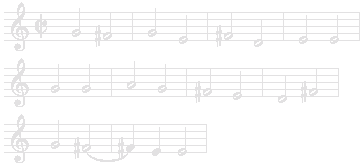|
| |||||||||||
|
| ||||||||||
| ||||||||||||||||||||||||
Hector Berlioz, Symphonie Fantastique, op. 14
|
|
There are some works of music which are so outstanding that they have gained quite a unique importance, making them stand for an entire era and influencing generations of composers until today. One of these works is Berlioz' only symphony; a symphony which has become the icon of the romantic era. What Berlioz (1803-1869) did with this piece of music was more than revolutionary, he basically created a definition of what romantic music meant, a definition via his example. - Following Beethoven's Sixth Symphony (The "Pastorale"), but going even further in instrumentation, atmosphere and structure, he laid out the concept of what is now being called program music.
The symphony follows a five-movement structure (as Beethoven's), a scheme which Mahler later came to follow, other than Bruckner and Tchaikovsky. Like Beethoven's Pastorale, he also provides the movements with headings and lays out a story which the symphony then will follow. So much for the similarities. What Berlioz does differently lies in the music itself - it can be heard very clearly: While Beethoven still more or less stuck to classical instrumentation, as well as to classical ways of letting the melodies and structures unfold, Berlioz is astonishingly modern, using a large orchestra and often seemingly erratic ways for the music to flow. There is no more pure logic primarily behind it, romantic music is driven by emotions, driven by itself even. Berlioz substitutes clarity for passion. What could be guessed within some of Beethoven's symphonies (the Ninth especially), was just this development - but even Beethoven was too conservative in his symphonies and still returned to classical schemes (as in his Eighth), while in his String Quartets he used to be much more passionate.
There is something else to Berlioz' Symphonie Fantastique - the story he is telling, that of the dreams of an artist, contains the image of the love of the artist - the loved one represented by an idée fixe, a principle later adopted by Wagner - the leitmotif:

The first movement, Rêveries (Dreams-Passions), presents us the leitmotif in its original form, we witness the artist dreaming of his love, of his emotions. The second movement, Valse: Un Bal (Waltz: A Ball), takes the traditional scherzo position here. But having a waltz in a symphony, such was formerly unthinkable. Berlioz breaks with traditions here - traditions and conventions which, once somehow established, hindered the music from further development. The leitmotif occurs at the end of this movement in a faster-paced style.
The third movement, Scène aux Champs (A Country Scene), is the slow movement. Note the solo violin and the fragile instrumentation, and how beautiful the atmosphere, this musical carpet unfolds here. This is the longest movement in the symphony, consequently continuing the line of thought behind Beethoven's slow movement in his Ninth. This is a striking difference between baroque and classical music on the one and romantic music on the other side - romantic music takes the time to unfold, it is a music of emotions, of passion, of silence also. The nice classical and baroque music might be, they tend to rush through the notes, barely taking time to explore a moment in greater length. The more I think of it, the more I see Beethoven as a romantic, less as a classical composer, judging from symphonies three, six and nine. But with Berlioz there can be no doubt here. -- Indications of thunder at the end of the movement lead over to the next one.
The fourth movement, Marche au Supplice (March to the Scaffold), depicts the artist after having killed his loved one in his dreams. It starts with a great crescendo, then leading into a march (!), first somewhat hesitatingly, preferring a more eclectic instrumentation, but then the march is led by the brass section. Successively, hell breaks loose and unfolds the entire scope of Berlioz' large orchestra. The idée fixe appears, then, decapitation.
The final movement, Songe d'une Nuit du Sabbat (Dream of a Witches' Sabbath), starts spooky and strange - reminding me of the Wolfsschlucht scenes from Weber's "Freischütz". Suddenly, the idée fixe can be heard - but sort of demonically distorted, illustrating the artist's dreaming of a witches' sabbath with his loved one joining the demonic creatures. The movement slows down until we hear bells (!!) introducing the following theme (called a Dies Irae theme in the original commentary; you can actually sing to it the words: Di-es i-rae, di-es il-la, sol-vet sae-clum in fa-vi-lla, ...), on which I will elaborate later on.

The grotesque chorale which sets in now is accompanied by bells and winds, going on for a while until the thing gains movement. The strings take the lead then with the dance theme, and after a slowdown and regained movement, forcing the above theme into a dominating counterpoint position in the coda. Again, please note the instrumentation at work here. Definitely far from Beethoven. The symphony ends furiously.
The Dies Irae theme from the fifth movement is something special - it is being used as a frequent quotation, kind of a running gag or an hommage to Berlioz, in a great many of musical works of the Romantic and Modernist era, even today it can be found. Check Mahler's first symphony, but you will also succeed finding it in the soundtrack for 'The Rock'. Berlioz' influence cannot be underestimated, and it is always nice to see how contemporary composers still honor their long gone predecessors.
(see also Doug Asselbergs' Berlioz page for further analysis)
|
| ||||||||||||
|
|
|
| |||||||||||